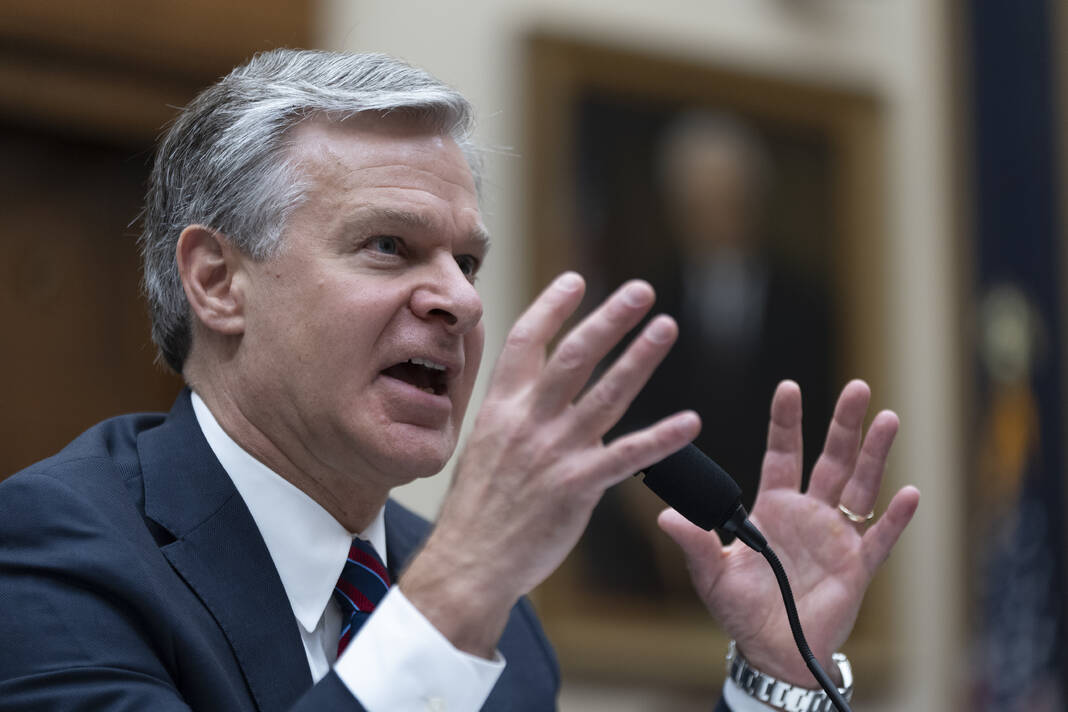
FBI Director Christopher Wray testifies Wednesday before a House committee about the July 13 shooting at a campaign rally in Butler, Pa., on Capitol Hill. Wray said that the FBI will “leave no stone unturned” in its investigation of the attempted assassination of former President Donald Trump.
Manuel Balce Ceneta | AP
WASHINGTON — The gunman in the attempted assassination of former President Donald Trump is believed to have done a Google search one week before the shooting of “How far away was Oswald from Kennedy?” FBI Director Christopher Wray said Wednesday, revealing new details about a suspect he said had taken a keen interest in public figures but had otherwise not left behind clear clues of an ideological motive.
The July 6 online search, recovered from a laptop tied to 20-year-old Thomas Matthew Crooks, is a reference to Lee Harvey Oswald, the shooter who killed President John F. Kennedy from a sniper’s perch in Dallas on Nov. 22, 1963.
“That is a search that is significant in terms of his state of mind. That is the same day that it appears he registered” for the Trump rally scheduled for July 13 in Butler, Pennsylvania, Wray told the House Judiciary Committee.
The FBI is investigating the shooting, which killed one rallygoer and seriously injured two others, as an act of domestic terrorism. Crooks was killed by a Secret Service countersniper. The investigation has thrust the bureau into a political maelstrom months before the presidential election, with lawmakers and the public pressing for details about what may have motivated Crooks in the most serious attempt to assassinate a president or presidential candidate since President Ronald Reagan was shot in 1981.
The agency has built out a detailed timeline of Crooks’ movements and online activity, but the precise motive — or why Trump, the Republican presidential nominee, was singled out — remains elusive, Wray said.
“A lot of the usual repositories of information have not yielded, anything notable in terms of motive or ideology,” Wray said.
The FBI’s assessment is that Crooks acted alone.
Wray noted that Crooks had grown interested in public officials — besides Trump, Crooks also had photos on his phone of Democratic President Joe Biden and other prominent figures — and in the days before the shooting had appeared particularly consumed by Trump.
Crooks is believed to have visited the rally site a week before the event, staying for about 20 minutes, and then returned on the morning of July 13. About two hours before the shooting, Wray said, Crooks flew a drone about 200 yards from the rally for about 11 minutes, using the device to livestream and watch footage and obtain what Wray said would have been a “rear view mirror” of the scene behind him.
The use of the drone, which along with a controller were recovered from Crooks’ car, so close to the rally site just hours before Trump took the stage add to the questions about the security lapses.
On the afternoon of the rally, Crooks attracted law enforcement scrutiny because of odd behavior around the edges of the event, including shouldering a backpack and peering into the lens of a range finder toward the rooftops behind the stage where Trump would stand within the hour.
Using what Wray said was mechanical equipment on the ground and vertical piping, Crooks was able to hoist himself up onto the roof of a squat manufacturing building that was within 135 meters (157 yards) of the stage. Crooks fired eight shots from an AR-style rifle before being he was killed.
The FBI thinks Crooks may have managed to avoid detection despite being armed because his weapon had a collapsible folding stock, Wray said.
Wray pledged to lawmakers that the FBI would “leave no stone unturned” in its investigation.
“I have been saying for some time now that we are living in an elevated threat environment, and tragically the Butler County assassination attempt is another example — a particularly heinous and public one — of what I’ve been talking about,” Wray said.
The hearing had been scheduled well before the shooting — as part of the committee’s routine oversight of the FBI and the Justice Department. Questions about the shooting dominated the session.
The FBI so far has avoided the same level of scrutiny over the shooting directed at the Secret Service over security failures that preceded the shooting and has led to the the resignation of Director Kimberly Cheatle.
Even so, Wray was not able to entirely avoid the antagonistic questions he typically receives from the Republican-led committee, a reflection of the lingering perception that the FBI and Justice Department have become politicized against Trump — something Wray has consistently denied.
That sentiment was made clear early in the hearing when the committee chairman, Rep. Jim Jordan, R-Ohio, told Wray: “I’m sure you understand that a significant portion of the country has a healthy skepticism regarding the FBI’s ability to conduct a fair, honest, open and transparent investigation.”


